Application of nanomaterials and nanotechnologies in construction. Рубрика в журнале - Nanotechnologies in Construction: A Scientific Internet-Journal
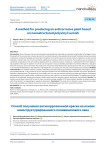
A method for producing an anticorrosive paint based on nanostructured polyvinyl varnish
Статья научная
Introduction. Most of the paint and varnish materials are produced from imported raw materials using foreign technologies. Due to the growth of the construction industry, demand for varnishes and paints has significantly increased. Varnishes and paints provide a protective coating for buildings and structures. Therefore, the need for paint and varnish products made from locally sourced materials is relevant not only in terms of import substitution, but also in terms of economics. The materials used as lacquers are composite compositions. They are made by applying them to a selected surface, resulting in a solid polymer film with appropriate properties. This type of materials is used to coat and protect structural building materials from external influences, and gives them the necessary color and texture. The production of nanostructured anticorrosive paints based on PVC has such advantages as environmental friendliness, high adhesion, high dispersion, low opacity, low viscosity, and environmental resistance. Methods and materials. The scientific research is aimed at obtaining nanostructured lacquer paint by modifying PVC with organic solvents and montmorillonite, a clay mineral of various extraction depths from the Talalaevsky deposit located 20 km from Sterlitamak, Republic of Bashkortostan. The purpose of the scientific work is to use clay minerals consisting of oxides and silicates of aluminum and magnesium with a small content of sodium and calcium salts, which act as nanostructuring binders. The performance characteristics of the obtained nanostructured paint samples were tested for adhesion, opacity, drying rate, and elasticity. Results. The research results have shown that the use of clay as a nanostructuring modifier of PVC paint makes it possible to obtain a product with characteristics corresponding to regulatory documents. Conclusion. This study aims to develop a nano-lacquer paint made from locally available raw materials that can be used to coat building facades and other construction surfaces.
Бесплатно
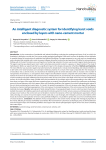
Статья научная
Introduction. In the construction of residential and industrial buildings, analyzing the underground layers of soil on which the foundation is built plays a crucial role. Due to poor-quality geological exploration of the earth's surface, the problem of karst sinkholes is revealed during the construction of residential and industrial buildings. The paper proposes to carry out work on strengthening water-saturated and unstable soils in order to prevent collapse during the construction and operation of facilities for various purposes. Drilling wells in the karst formation zone and injection of reinforcing material is the main way to protect against karst phenomena. The paper examines gas-liquid layers (karst voids) containing nanocrystals located in a gaseous or liquid medium. The study of hydrodynamic fields is an urgent task that has a significant impact on the design and operation of facilities. Methods and materials. The most effective way to protect against karst phenomena for already built or newly erected buildings and industrial facilities is to drill wells in the karst formation zone and inject reinforcing material. As a result of the study conducted after the introduction of nanosilicon into a cement mortar, it is found that the hardening time of cement decreases with an increase in the number of nanoparticles of nanosilicon, i.e. nanoparticles have a higher rate of hydration reaction compared with cement. When a reinforcing material in the form of nanosilicon with cement mortar is introduced into the rock thickness of the karst formation zone, forming a lower insulating and upper stabilizing layer that prevent water access to the karst at the depth of the karst rock and stabilize the surface. At the karst formation stage, located within the boundaries of the collapse prism and corresponding to the width of the lower layer, two layers of the upper and lower supporting layer are created. Groundwater flow channels from catchments to discharge zones are formed between rock-thick support layers and insulating stabilizers that support the natural hydrogeological regime of the rock strata containing karst water layers. As a result, the protective properties of the rock increase when signs of karst appear, the physico-chemical and bearing properties of the soil improve, the strength properties of the soil increase and the likelihood of landslides decreases. Results. Hydrodynamic fields during filtration of nanogasated liquids in karst voids have been theoretically studied. Discussions. By installing a permanent automated monitoring system for motion sensors, pressure and temperature of liquid and gas in karst voids on the control well, we will be able to monitor the dynamics of the main hydrodynamic parameters of karst voids, allowing us to assess the current regime of karst voids and, in case of danger, alert emergency services and residents of the house. By monitoring the operation of sensors using artificial intelligence, it is possible to predict the occurrence and development of critical situations. Conclusion. The addition of silica nanoparticles to the cement mortar changes the rheological properties of the mortar, affecting its viscosity and fluidity. Groundwater flow channels from catchments to discharge zones are formed between rock-thick support layers and insulating stabilizers that support the natural hydrogeological regime of the rock strata containing karst water layers.
Бесплатно
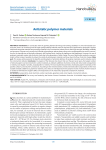
Статья научная
Introduction. In connection with the growing demand for living and working conditions in civil and industrial construction, there is an increasing need for high-quality building materials with the required set of performance properties. Polymer reinforced composite materials are promising materials in the construction industry due to their high strength, durability, reliability and economy. Polymers such as polyvinyl chloride, polyurethanes, polyacrylates, epoxy resins, polypropylene are used in construction for the manufacture of decorative elements, self-leveling floors, coatings for appliances and equipment. However, the use of polymeric materials creates risks of electric shock due to the generation of static charge. The use of electrically conductive nanomaterials as fillers makes it possible to reduce the resistivity of polymeric materials and slow down the flow of electric charges. Main part. This review article presents the benefits and drawbacks of antistatic additives for polymer materials used in industry and in the construction industry. Conclusion. An analysis of the literature has shown that over the past seven years, the largest number of relevant papers has been devoted to carbon materials as antistatic additives (8 articles), metal and metal oxide nanoparticles (7 articles), ionic liquids (7 articles), and polyaniline (7 articles). The most studied characteristics of antistatic polymer materials are the specific surface RS and volume RV resistances. According to the reviewed articles, metal and metal oxide nanoparticles are the most suitable antistatic additives to polymeric materials, since they are well dispersed in the polymer matrix. However, further research is needed to eliminate the negative effect of nanoparticles on the mechanical properties of polymeric materials.
Бесплатно
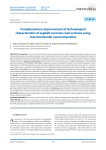
Статья научная
Introduction. The issue of enhancing the long-term performance of asphalt concrete pavement on highways is not entirely addressed by conventional solutions, such as improving the choice of material composition and refining the production process for bitumen binders and mineral filler compounds. One of the most promising ways to improve the performance and durability of asphalt concrete is the complementary modification of bitumen and road-concrete nanocompositions with thermoplastic and elastic polymers. Methods and materials. Bitumen binders are assessed employing suitable methodologies to determine the following technological parameters: extensibility, softening temperature, brittleness, elasticity, and so forth. Asphaltenes of bitumen binders are the most important structure-forming component and form associated nanoclusters with sizes of 15–200 nm. Thermoplastic block copolymers are introduced into the composition of bitumen binders in granular form (chips) or melted form. Additionally, compatibilizers are used to improve the compatibility of complementary copolymers in bitumen binders. The quality of the finished asphalt concrete composition is significantly affected by the characteristics of the main components: mineral powder, sand, crushed stone, bitumen binder and macromolecular nano-additives, as well as by optimal process modes: mixing temperature, etc. Results. The complementary interaction of supramolecular associations of asphaltenes and fragments of macromolecules of polymer nanocomposites ensures the formation of Van der Waals bonds due to spatial mutual correspondence. The introduction of polymer nanomodifiers leads to an increase in the softening temperature and a decrease in the brittleness temperature of bitumen binders due to the formation of sufficiently stable supramolecular complexes. Discussion. Synergistic nanoadditives of complementary macromolecules into the bitumen binder provides a fewfold increase in the adhesion of the bitumen composition and the mineral components, as well as a noticeable increase of the temperature range for plasticity and deformability. Asphalt concrete coatings with polymer-bitumen binders increase the operability of the roadway and resistance to the formation of plastic flow deformations (shifts, ruts) at high and low temperatures. Conclusion. Bitumen binders of asphalt road concrete, which have been modified with polymer nanocomposites, have higher adhesion, an extended range of thermoplasticity and water resistance.
Бесплатно
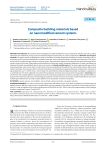
Composite building materials based on nanomodified cement systems
Статья научная
Introduction. This research work investigates the combined influence of nano-sized silicon dioxide (nano-SiO2), carbon nanotubes and surfactants on the structural and technological characteristics of cement compositions. Materials and research methods. The paper reveals the findings of a study on the effects of various dispersion techniques of carbon nanotubes (CNT) in surfactants, such as mechanical dispersion, ultrasonic treatment, and a combined method. It considers the uniformity of CNT distribution within the plasticizer and within the cement system, along with their impacts on the physical and mechanical properties of cement stone and concrete. Differential thermal and electron microscopic analysis of aqueous dispersions of carbon nanotubes and hardened activated nanomodified cement stone was carried out. Results and discussion. It has been experimentally proven that mixing nanotubes in dry cement does not allow them to be evenly distributed throughout the volume of the mixture. When using carbon nanotubes, the maximum effect is achieved when they are introduced into aqueous dispersions of plasticizers. The percentage of plasticizer was 1%, CNT 0,1% per 1 liter of water. The most effective method of dispersing carbon nanotubes in a plasticizer is a combined one. The results obtained were used in the preparation of cement stone and concrete compositions. Conclusion. The results show that complex additives consisting of nano-SiO2 and aqueous dispersions of carbon nanotubes have a positive effect on the physical-mechanical and structural-technological properties of cement stone and concrete. Graphic dependencies are shown indicating the effectiveness of using complex additives in the production of cement composites.
Бесплатно
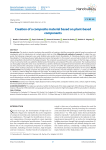
Creation of a composite material based on plant-based components. Nanotechnologies in construction
Статья научная
Introduction. The study is aimed at analyzing the possibility of creating a building composite material based on amylose and amylopectin with the introduction of crushed walnut shells as a filler. Materials and methods of research. To obtain the composite, the following components were used: distilled water, potato starch (NevaReaktiv, St. Petersburg, Russia), acetic acid 70% (NevaReaktiv, St. Petersburg, Russia), highly dispersed walnut shell powder. For this research, we used walnut shells of the Chandler variety (engrafted) collected form the Belgorod region. The composite was produced in several stages. At the first stage, a mixture of starch and walnut shells was added to distilled water, followed by a pre-prepared 9% acetic acid solution. The resulting mixture was thoroughly mixed, after which it was transferred to a stainless-steel bowl and subjected to heat treatment. The resulting mixture was then pressed with solid-phase compaction method at a pressure of 72 MPa. We studied the physical and mechanical characteristic of the resulting composite, its thermal properties, as well as the hydrophobic-hydrophilic balance of the surface. Results and discussion. The resulting composite has good strength characteristics. Flexural strength at break is σf = 25.85±2.51 MPa and σf = 28.44±5.71 MPa for filling 50% weight and 75% weight. Accordingly, they put it on a par with similar composites made from more conventional thermo- and thermoset polymers. The temperature limit for the composite material exploitation has been established, the upper of which can be considered the temperature at which the polymer matrix begins to soften – 103.1 °C. Conclusion. The results obtained are crucial for understanding the mechanisms involved in creating composite materials made entirely from plant components, utilizing, among other factors, agro-industrial waste.
Бесплатно
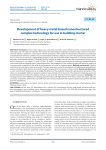
Development of heavy metal-based nanostructured complex technology for use in building mortar
Статья научная
Introduction. Heavy metals (copper, zinc, nickel, lead, chromium, cobalt, cadmium) get into constructional materials with natural and man-made raw materials. The chemical and mineralogical composition of large-tonnage wastes from the petrochemical industry is perfect for constructional materials production. Heavy metals in constructional compositions provide high strength and frost resistance. Currently, nanostructured metal-containing complexes are used in the production of mortars. Therefore, it is necessary to ensure the reliable binding of heavy metals into structurally stable compounds to avoid their emission and secondary environmental pollution. The steadily growing volumes of sludge reservoirs with high concentrations of heavy metals such as chromium (Cr +6), copper (+2), lead (+2), iron (+2), and Fe (+3) cause particular interest to researchers. Qualified extraction of the listed metals and binding them as nanocomponents in the composition of the complexing agent will ensure the creation of a nanostructural composition in the recipe for the preparation of mortar for various purposes. Methods and materials. Sorption methods are the main way to isolate heavy metals. The paper proposes a method for the production of alkyleneaminopolycarboxylic acids and studies its ability to form nanometallic complex compounds for the extraction of heavy metals. Results and discussions. In order to bind metal nanoparticles in oil sludge, the efficiency of the produced compounds, carboxymethyl derivatives of hexamine, was investigated. Optimum synthesis conditions were selected and the structure of the obtained complexing agents was proved by infrared and ultraviolet radiation methods as well as by the method of nuclear magnetic resonance. Conclusion. The resulting nanostructured additions have binding properties that provide high adhesion of the heavy metal to the organic substrate and mortar components, which makes it possible to provide a strong composition that maintains operational properties that meet technical requirements.
Бесплатно
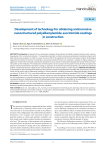
Статья научная
Introduction. At present, the use of polymer coatings in the protection of metallic materials and structures is becoming popular in the construction industry. It is especially important to obtain nanostructured polymer insulating materials with high anticorrosive properties in order to ensure the service life of the equipment of the fuel and energy complex. Technological equipment during the extraction, transportation, processing of petrochemical raw materials is subject to regular exposure to aggressive environments. Damage to production equipment causes annual environmental damage and human health and material burden on the enterprise. The introduction of heteroatoms into the structure of the polymer molecule helps to improve the physico-chemical characteristics of polymer coatings, in particular, to increase the protective properties, since natural and synthetic polymer compounds represent a large cluster of supramolecular structures located in a certain sequence. Methods and materials. A technology has been developed for obtaining new polymeric nanostructured alkenylsuccinimides with anticorrosive properties, which can be used as part of lubricating coatings in various industries, including construction. Alkenylsuccinimides were tested according to TS 38101147-77 for succinimide additives and showed compliance with their standards TS 38101247-77. Results and discussions. In the course of the research a resource-saving non-waste technology of obtaining a nanostructured polymer additive with polyamines as a nanostructuring base to provide an anticorrosive effect has been developed. Conclusion. The obtained compounds based on triethylenetetramine, tetraethylenepentamine, alkenylsuccinic anhydride can be used as effective polymeric anticorrosion additives in the processing of metal materials and structures in the construction industry.
Бесплатно
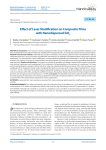
Effect of laser modification on composite films with nanodispersed SiO2
Статья научная
Introduction. This research is aimed at studying the effect of laser modification on composite films obtained on the basis of polyimide track (nuclear) membranes and filled with nanodispersed SiO2; to change their optical and structural properties. Materials and research methods. Polyimide track (nuclear) membranes were used as a polymer matrix. Track diameter is 200 nm, membrane thickness is 25 μm. The tracks were filled with nanosized SiO2 by hydrolysis of tetraethoxysilane in the presence of track membranes. For composite film surface modification, we used ytterbium pulsed fiber laser Minimarker 2-20 A4 PA. We studied the change in the surface microscopy of composite films, their optical density, IR-Fourier spectra and surface wettability depending on laser treatment. Results and discussion. The authors have found the possibility of creating a composite film based on a polyimide track (nuclear) membrane and nanodispersed SiO2 by hydrolysis of tetraethoxysilane in the presence of a membrane. It is shown with the energy dispersive analysis method that silicon oxide has completely filled the pore volume of the track membrane. Laser modification of the composite material surface (composite film) leads to an increase in the contact angle of wetting from θ = 66.75 ± 1.55° to θ = 101.52 ± 3.03°. Thus, the material acquires hydrophobic properties. Also, the laser films modification has a positive effect on the transmittance of the films, namely, this coefficient increases. The greatest change is observed in the infrared region of еmitted spectrum, the average increase in transmission is +70.48%. Conclusion. The obtained results of the study are of great importance for understanding the mechanisms of creating composite films with improved optical properties, which can later be used to create composite films with desired optical properties for various applications.
Бесплатно
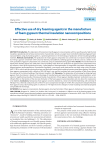
Статья научная
Introduction. The elaboration of foamed eco-friendly gypsum nanocomposites with low specific gravity, high thermal insulation, operational and technical and economic characteristics remains an urgent task. Controlled hardening of gypsum foam nanoassemblers using dry foaming agents is a promising direction in the technology of production of heat-insulating building materials. Methods and materials. The production of a foam gypsum composition was carried out in an ejector-turbulent mixer by mixing a gypsum nanobinder with functional foaming nanoadditives. Building gypsum G5 BII was used as a binder in the work; porization of gypsum compositions was carried out using an adsorbed foaming agent PBNS. Results. The transformation of liquid-phase foaming agents into solid-phase ones by binding water allows the production of gypsum foam compositions from dry mixtures, which gives high dosing accuracy, a good degree of homogenization of components and stable characteristics of foamed gypsum nanocompositions. In production conditions, a one-storey small-sized pavilion was built using a pilot 3D printer AMT S1160, in which vertical enclosing structures are filled with foamed heat-insulating nanostructured foam gypsum. Monolithic foam gypsum nanomaterial with a density of 300–400 kg/m3 was used for insulation and sound insulation of attic floors during the overhaul of the historic building of the Veterans Hospital in Ufa. Discussion. The elaboration of technology for obtaining foam gypsum from dry mixtures is based on the advantage of manufacturing and using thermal insulation nanocompositions, which allows for significant punctuality of dosing and stable characteristics of foam gypsum building materials. Surfactants have a significant effect on the kinetics of the structure formation of the foam gypsum nanocomposition and slow down the coalescence of air bubbles. Conclusions. Nanoporous foam gypsum concrete, obtained as a result of controlled hardening, with a density of 400 kg/m3 has a thermal conductivity of 0.12 W/(m•ºС) and a compressive strength of 1.4 MPa. The compressive strength of foamed foam gypsum using a dry foaming agent on sorbents is 17% higher than the strength of a heat-insulating nanomaterial prepared using traditional technology.
Бесплатно
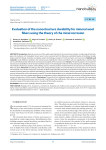
Статья научная
Introduction. Mineral wool is one of the widely used materials in the construction industry. A wide range of technologies and structures with integrated mineral wool is also connected with the following: ventilated facades of buildings, facades made using FICS (facade insulation composite system) technology, insulation of roofs and attics, and much more. Methods and materials. Under different conditions, the nanostructure durability for mineral wool fibers will vary significantly. Currently, there are no scientifically based methods for assessing the durability of the nanostructure. Results. The article proposes to evaluate the nanostructure durability for the of mineral wool fibers based on the developed method of chemical destruction of building ceramics. The methods of laboratory analysis of the building ceramics material and their modernization for the nanostructure of mineral wool fibers are given. Discussion. According to the results of experimental studies, it was found that the corrosion process in the mineral wool material occurs by the mechanism of reaction of alkali metal hydroxides with silicon and aluminum oxides in the mineral wool material, removing them into solution and leading to chemical destruction of the material, which is generally similar to the studied process of destruction of the wall ceramics material. The results obtained allow us to conclude that the process of chemical destruction of mineral wool has a greater dependence on temperature and less dependence on the concentration of hydroxides than the process of destruction of brick material. Conclusions. The results of the conducted studies allow us to calculate the temperature coefficient of the destruction process rate in the Van't-Hoff formula, the coefficients in the Arrhenius equation and the value of the activation energy of the destruction process. Examples of field studies are given.
Бесплатно
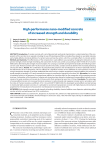
High-performance nano-modified concrete of increased strength and durability
Статья научная
Introduction. To create concrete with a set of physical and mechanical characteristics, a rational selection of the components of the concrete mix is required, including the use of finely dispersed fillers, including those based on recyclable materials, and a highly effective chemical additive of a certain nature and reactive action, which has a complex effect on concrete system. Methods and materials. The effectiveness of the components in used additive was assessed by changing the indicators of compressive strength, tensile strength in bending, the assessment of which was carried out according to GOST 10180-2012 “Concrete. Methods for determining the strength of control samples. For carrying out scientific and experimental studies, the following materials were used: Portland cement CEM I 42.5N; natural sand; fine microsilica; complex chemical additive with increased plasticizing and reactive effects. Results. The combination of polycarboxylate polymers and nanodispersions of silicon hydroxide enhances the effectiveness of each component, which is reflected in a significant increase in the coefficient of crack resistance of concrete at high compressive strength. It has been established that when using a complex nanopolymer chemical additive, the increase in tensile strength in bending is 67% and it exceeds the increase in compressive strength by more than 30%. Discussion. An increase in hydration activity in the presence of a nanopolymer additive has a positive effect on the compaction of the emerging concrete structure. Confirmation of the formation of a dense and strong structure during the hardening of nanomodified concrete is an increase in the water resistance of concrete by 2.5 times and its frost resistance by more than 2.5 times. Conclusion. The advantage of nanomodified concrete is its increased chemical resistance to carbon dioxide and magnesia corrosion and, in accordance with the index of chemical resistance coefficient, CCSт> 0.8, and GOST R 58895-2020, the developed nanomodified concrete belongs to chemically highly resistant concretes. It is advisable to recommend nanopolymer concrete with high physical and mechanical properties for the manufacture of structures for overhead power transmission lines (OPL).
Бесплатно
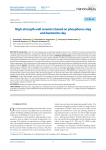
High-strength wall ceramics based on phosphorus slag and bentonite clay
Статья научная
Introduction. One of the promising ways to get high-strength ceramics is the method of semi-dry pressing of the "coarsely dispersed component – finely ground binder" formula. This method suggests using crushed industrial waste as the core, and finely ground nanostructured fusible clay as the binder material. Methods and materials. In the research, bentonite clay of the Darbazinsky deposit of the Turkestan region was used as plastic material, and dense crystallized phosphorus slag which is a waste of phosphorus production was used as a non-plastic coarse material. The study of the prescription factors’ influence on the basic physical and mechanical properties of ceramic wall materials was carried out by the simplex method characterized as lattice planning of experiments. The nanostructure of the phosphorus slag and bentonite clay formula was studied by the electron microscopic analysis method. Results. The binder content in the amount of 25% guarantees the density of the packages, while the sintering effect becomes sufficient and the strength of the samples is 27.1 MPa. If the amount of binder increases from 25% to 40%, the sintering effect continues to grow and the strength of the samples reaches 54.3 MPa. Discussion. The results show that the most active sintering effect and the dense structures forming in coarse-grained formulas with high-calcium phosphorus slag occur at 40–60% binder content. The presence of flux around slag grains in an amount of less than 30% contributes to obtaining less dense samples, with a binder content of 40%, a density increase is observed, which corresponds to the mixed ceramic structures modeling. Conclusion. To get high-strength ceramic bricks, the content of coarsely dispersed components in the form of phosphorus slag with a fraction of less than 1.25 mm should amount to 60–70%, finely ground phosphorus slag should be 5–10%, and bentonite clay is to be 20–30%. Optimum technological indicators are: calcination temperature 1050–1100oC, pressing pressure 20–25 MPa, press powder moisture content 7–8%.
Бесплатно
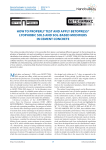
How to properly test and apply BETOPRESS® lyophobic sols and sol-based modifiers in cement concrete
Статья научная
This article provides information in the accessible form about a completely different approach to the testing and application of lyophobic sols and sol modifiers in cement concrete, in contrast to any other chemical additives that are classified as true solutions in liquid form. The criteria outlined in clause 6.11 of GOST 27006-2019 for the selection of compositions produced in laboratory conditions cannot be extended to sols and sol modifiers, which are stabilized colloidal solutions. This specifically pertains to the preparation of concrete mixtures for subsequent testing. GOST 27006-86 was released during a period when all chemical additives used in concrete were solely available in the form of true solutions, comprising fully dissolved molecules and ions resulting from the complete dissolution of all components in water.
Бесплатно
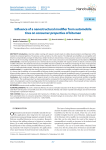
Influence of a nanostructural modifier from automobile tires on consumer properties of bitumen
Статья научная
Introduction. Used tire rubber cracking with organic solvents leads to rubber devulcanization and dispersion of the material to nanosized particles. The process can be carried out in a flow reactor. The obtained nanomodifiers are compatible with bitumen and predictably change the bituminous binder technical characteristics. Various practical solutions have been proposed for the use of the resulting modified bituminous binders in the road construction and strengthening soil foundations. Methods and materials. It has been proposed to use a method of joint cracking of rubber with organic solvents to obtain a nanostructured modifier of bitumen. The obtained nanostructural modifier has been studied by the methods of analyzing the sizes of nanoparticles and solubility in toluene. For the bituminous binders obtained with the use of nanomodifiers, standard characteristics for bitumen, such as needle penetration depth, softening temperature, brittleness temperature and extensibility have been determined. Results and discussion. It is established that during the proposed process, a nanostructural modifier compatible with bitumen is formed. It is shown that the addition of a nanomodifier to bitumen makes it possible to purposefully change the properties of the resulting bitumen binder, improve the consumer properties of the bitumen binder and expand its application areas. It is proposed to use the obtained product as a component of waterproofing mastics for waterproofing the underground parts of buildings and structures. Conclusion. Joint cracking of rubber with organic solvents in a flow reactor allows obtaining a nanostructural modifier compatible with bitumen. The resulting product has improved properties compared to the original bitumen, which expands its scope of application. It is proposed to use the resulting product for the manufacture of waterproofing mastics. The proposed technical solutions make it possible to reduce the environmental load of automobile tires wastes.
Бесплатно
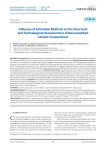
Статья научная
Introduction. We studied the effect of nanosized silicon dioxide (SiO2) on the structural and technological characteristics of nanomodified cement compositions introduced together with activated mixing water. Materials and research methods. Activation of mixing water was carried out by means of magnetic field and ultrasonic action. For investigation the capability to maintain their properties for a long time, the stability of silica suspensions in activated water was studied. For finding out the effect of activated silica suspensions on the structure and properties of composite materials based on cement, the physical and mechanical properties of the studied compositions were explored. X-ray and differential thermal analysis of the hardened activated nanomodified cement paste were also carried out. Results and discussion. The positive role of the suspension of silicon dioxide in activated water was associated with a decrease in the microheterogeneity of the hardened cement paste, ensuring the stability of its physical and mechanical characteristics. Based on the above mentioned observations, a mechanism was proposed for more efficient incorporation of nanosized silicon dioxide into cement hydration processes both due to chemisorption with Ca(OH)2 in the hardening cement paste and due to the topological effect of nanoparticle localization in defects and ultramicrovoids of a crystallizing disperse system. Conclusion. The results show that suspensions of silica in activated water can maintain their properties for a long time. Graphical dependencies are shown, indicating the effectiveness of the use of activated silica suspensions in the production of cement composites. This quality makes it possible to obtain repair compounds with the required properties during construction work for various purposes.
Бесплатно
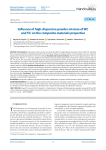
Influence of high-dispersive powder mixture of WC and TiC on the composite materials properties
Статья научная
Introduction. The purpose of the research is to study the effect of a high-dispersive powder mixture of WC, TiC, obtained from recycling of hard-alloy manufactured articles from TK group (titanium-tungsten alloys), on the change in the structural and physical and mechanical properties of cement materials. Materials and research methods. WC, TiC Powder (particle size 20–150 nm, agglomerates 300 nm – 1.5 μm) was added to the cement mortar by partial replacement of cement in various concentrations of 0%, 1%, 2%, 3%, 4%, 5% by mass. The basic physical and mechanical properties of the cement paste and obtained cement materials were studied in accordance with standard methods, taking into account regulatory documents of Russian and foreign standards. Thermokinetic, X-ray phase analysis, scanning electron microscope investigation with an integrated system of energy-dispersive analysis were also applied. Results and discussion. It has been proved that highly dispersed WC, TiC powder additive to cement materials leads to increase in density, paste fluidity, reduction in setting time, decrease in water absorption, porosity, and increase in strength characteristics both in early and later periods of hardening. A highly dispersed additive promotes earlier hydration. The structure of the cement sample with powder additive is denser throughout the considered periods of hardening compared to the control sample. Conclusion. The obtained results are of great importance for understanding the action mechanism on cement materials of highly-dispersed particles of WC, TiC, which can later be used to improve the properties of composite cement-based materials in various fields of application.
Бесплатно
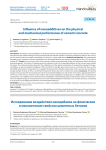
Influence of nanoadditives on the physical and mechanical performance of cement concrete
Статья научная
Introduction. The influence of nanoadditives on the physical and me-chanical performance of cement concrete remains a relevant issue driven by the need for finding the most promising and cost-effective solutions to enhance performance during in situ concreting. This issue has been thoroughly examined by the authors in earlier publications. Methods and Materials. Two experimental formulations of a composite concrete nanoadditives were developed, based on ammonium hexafluorosilicate ((NH4)2SiF6) and silicon carbide (SiC). Results. In the first part of the study, concrete samples were tested after 28 days of hardening to assess mechanical strength properties. The kinetics of hardening and the influence of each of the specified additives on the concrete were studied. Discussion. The conducted studies allowed for the establishment of the optimal combination of nanoparticles included in the special additive, as well as a detailed investigation of the mechanism of strength gain in cement stone. It was found that the use of the best additive formulation (combination No. 2) significantly improved the strength characteristics of the concrete mix, providing an average strength increase of 38%, as confirmed through both destructive and non-destructive testing. Conclusion. The optimal dosage of nanocomponents for the production of the recommended additive per cubic meter of concrete is approximately 0.0141 of the mass of the main raw material, which confirms the economic feasibility of its application. In addition, low concentration of nanoparticles in the additive ensures environmental compatibility of the finished product, minimizing the impact on the environment. The optimal dosage of nanocomponents ensures the uniform distribution of particles in the concrete structure, contributing to an increase in its durability and resistance to environmental influences.
Бесплатно
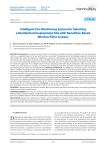
Статья научная
Introduction. The industrial activities result in the release of a significant number of pollutants into the atmosphere, which have a negative impact on human health and the environment. The development of sustainable principles for construction sites development requires the elaboration of algorithms, assessment methodologies, and monitoring of the environmental situation at the construction site. Analysis of research works in the field of environmental monitoring of air pollution by hazardous substances has shown that the speed and reliability of the obtained information are crucial in polluted atmospheric conditions. In this article, we examine the application of an intelligent environmental monitoring system with Salavat city Republic of Bashkortostan as the example. The article presents an example of continuous eco-monitoring using three automatic air pollution monitoring stations for controlling the atmospheric air in residential areas. Methods and Materials. An intelligent eco-monitoring system is proposed, which is capable of assessing the state of the air basin of an industrial city, identifying sources of increased air pollution, processing information using an artificial neural network in real-time, generating control actions on sources of increased air pollution, and providing recommendations to businesses for optimizing their operations to prevent exceeding the maximum allowable concentrations of harmful substances. Results. The analysis of air quality in Salavat has led to the conclusion that it is necessary to install window filter-screens with nanofiber-based filtering elements in residential buildings. Discussion. The results of the air basin monitoring can be used in an integrated intelligent environmental monitoring system for assessing environmental conditions and can be made available to interested parties. Considering the results in Salavat, the project can be replicated for use in eco-monitoring systems of towns and cities in the Russian Federation. Conclusion. As a result of the project, the program utilizing artificial intelligence has been developed, which will contribute to reducing the level of air pollution in the future.
Бесплатно
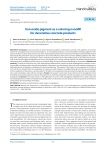
Iron oxide pigment as a coloring nanofill for decorative concrete products
Статья научная
Introduction. Current research on the performance properties of decorative concrete, when added to the concrete mixture of nano pigments are more recommendatory. In the academic literature, it is recommended to introduce pigment in the amount of about 5% of the total cement mass when creating improvement elements. The recommendations described above often demonstrate the potential for using nano pigments in terms of the influence of the amount of nano-additive applied on the uniformity of the coating texture. Characteristics such as intensity and retention time of the resulting color are also taken into account. In RF we do not have approved regulations on how to use pigments for concrete coloring. Pigments are obtained mainly from iron oxides due to their availability and low toxicity to the human body, and are promising nanomaterials in construction. Methods and materials. The study is aimed at the use of iron oxide pigment obtained from a spent iron oxide dehydrogenation catalyst as a coloring nanofiller and improving the strength characteristics of decorative concrete products. Spent iron oxide catalysts containing iron oxide particles are considered as a by-product of chemical production. The purpose of this study is to use a pigment (in the form of Fe2O3 and Fe3O4) obtained from the composition of a spent iron oxide catalyst as an additional binder and coloring nanomaterial in the composition of decorative concrete products. The effect was evaluated by testing mechanical properties such as strength, color, water absorption, water and frost resistance. Results. The research results have shown that the use of nanopigment in the technology of concrete production improves the properties of cementing composites (cement) and allows you to change the color of products. Conclusion. This study consists in the application of an iron oxide nanopigment obtained from a spent catalyst for the dehydrogenation of olefins and alkylaromatic hydrocarbons in decorative concrete products with the provision of mechanical characteristics and chromaticity of products.
Бесплатно

